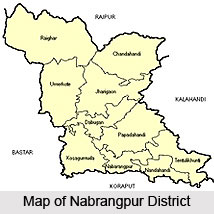 Since Nabrangpur existed as a sub divisional section of the Koraput district, its ancient history is closely knitted with Koraput. In a sense the language, style of living, heritage, geographical location flora and fauna and even climate of the Nabrangpur district is not distinct from the rest of the component of Koraput district. As far the history of Nabrangpur is concerned, it was the kingdom of the valiant Atavika people, who fought the dreadful Kalinga war in the 3rd century B.C. Kalinga became the sovereign land of Mahamegha Bahan dynasty in the first century BC. The third king of the dynasty Kharvela made the Kalinga empire and the Atavika land very strong.
Since Nabrangpur existed as a sub divisional section of the Koraput district, its ancient history is closely knitted with Koraput. In a sense the language, style of living, heritage, geographical location flora and fauna and even climate of the Nabrangpur district is not distinct from the rest of the component of Koraput district. As far the history of Nabrangpur is concerned, it was the kingdom of the valiant Atavika people, who fought the dreadful Kalinga war in the 3rd century B.C. Kalinga became the sovereign land of Mahamegha Bahan dynasty in the first century BC. The third king of the dynasty Kharvela made the Kalinga empire and the Atavika land very strong.
Following the Atavikas, the successive dynasties - the Satavahans (2nd century AD) two Ikshvakus (3rd century AD) has their dominion over the Koraput district, as is known from the history of Nabrangpur. The historical documents of Nabrangpur also depicts that these two dynasties had kinship with the Nalas (3rd and 4th century AD), with a head quarter located at Pushkari, near the modern Umerkote town of Nabrangpur district.
The erstwhile Koraput is a small principality under the Gangas who flourished in the 5th century ` AD. The territories of Odra, Kalinga and Kosala were brought under the control of Ganga kings during this period. But as the ancient history of Nabrangpur runs this dynasty became prominent during the 11th century AD with the rise of Somanakshi, the celebrated ruler of the Ganga dynasty. Their suzerainty extended from the modern Sambalpur, Sonepur to Bastar - Koraput regions and they enjoyed control till the beginning of 14th century AD. According to the historians, during the Ganga era, they were the sole master of the extended region of Koraput and subdued all the revolt raised against them. The throne of Koraput was succeeded by the Matsyas and the Sailavansis respectively after the Gangas lost their supremacy in Koraput.
During the Anglo-French strife Vikram Dev I, successfully ousted the French from Malkangiri area and the Marathas from the Umerkote belt. As the history of Nabrangpur depicts, the Sailavansis continued to be in the throne even in the British era and Ramachandradeva IV, a Sailavansi also had served as the efficient lieutenant of the World War I. During this period the Boundary Commission headed by Sir O`Donnell was entitled for inspecting the entire Oriya speaking tract. The state of Orissa was formed as a separate administrative province on 1st April 1936 and Koraput was adjoined with it being an Oriya speaking land. In the post independence period, also the district of Nabrangpur was a subdivision of Koraput district in Orissa. Due to administrative convenience the Nabrangpur subdivision was separated from Koraput district in 1992 and identified as a separate administrative district.



















